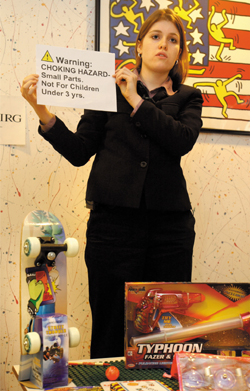
Diane Brazzel of PIRG held a press conference at Vanderbilt last week about toy safety. (photo by Dana Johnson)
VCH encourages holiday awareness of toy dangers
Vanderbilt Children’s Hospital accident prevention specialists, along with a national consumer group, are warning shoppers to be wary this holiday season of certain toys that can prove fatal to children.
In its annual “Trouble in Toyland” report, the U.S. Public Interest Research Group (U.S. PIRG) highlights potential hazards posed by toys found during a survey of stores in October and November. PIRG cautions consumers about toy hazards in five categories: choking hazards including balloons, toxic chemicals, hearing loss hazards, scooter dangers, and purchasing toys on the Internet. PIRG also identifies toys that do not have manufacturer information, which makes it difficult for consumers and government officials to identify and recall unsafe toys.
Rhonda Phillippi, R.N., assistant in Pediatrics at Vanderbilt Children’s Hospital and director of Tennessee EMS for Children, urges parents to use caution and think of safety when purchasing toys for their children in the upcoming holiday season.
“It is important for parents to realize there are toys out there which can harm their children,” Phillippi said. “This report can serve as an excellent guide for parents to follow when looking over their child’s Christmas list.”
Phillippi went on to explain that the largest number of deaths and injuries in children will still result from motor vehicle crashes, and parents need to be sure that everyone in the car is using age-appropriate restraint devices.
“With all of the travel that occurs over the holidays, we need to make sure we can protect our children while on the roadway,” she said.
According to data released recently by the Consumer Product Safety Commission (CPSP), in 2001 there were an estimated 255,100 toy-related injuries treated in U.S. hospital emergency rooms. There were 25 toy-related deaths, including nine children who choked to death on balloons, toy balls and small toy parts.
More than 20,000 pediatric patients are seen annually in the VCH Emergency Department, of which 30 percent are admitted. VCH is Middle Tennessee’s only Comprehensive Regional Pediatric Center for emergency care and transfers.
Dr. Andrea Bracikowski, associate professor of Emergency Medicine and Pediatrics, and director of the Pediatric Emergency Medicine Department for Vanderbilt Children’s Hospital, said it was important for parents to pay attention to small parts on toys that can cause choking hazards.
“Tragically, children continue to choke on balls and other round or cylindrical toys that are small enough to block their airway,” Bracikowski explained. “It’s one of the biggest problems we see in the emergency room.”
Mary Fran Hazinski, R.N., assistant in Surgery & Pediatrics, division of Trauma and Surgical Critical Care and Trauma Prevention Specialist, Vanderbilt Children’s Hospital, stressed the importance of giving a helmet with any bicycle, and a helmet and pads with any scooter, skateboard or skates.
“Parents should know that helmets can reduce the severity of bicycle-related head injuries by approximately 85 percent, and parents need to require that kids wear them every time,” Hazinski said.
Some of the toys included on the list are:
• Clifford the Big Red Dog Wind-Up Toy, made by Toy Island Manufacturing, listed because of small parts and no CSPA warning/non-statutory warning.
• Happy 2nd, 3rd, 4th… Birthday Balloons made by the Pioneer Balloon Company. The balloons have the proper statutory choke warning, but are inappropriate because the targeted audience is younger than 8 years old.
• Hello Kitty Super Bouncy Ball made by Sanrio Co., Ltd. This ball fails the small ball test; packaging lacks CSPA choke hazard warning.
• Lil’ Chefs 50-Piece Play Food Set made by Geoffrey, Inc. This toy was included because it contains round plastic fruit that barely passes the small part test and fails the small ball test.
• Sanrio pink glitter nail polish, made by Sanrio Co., Ltd. The product contains dibutyl phthalate. Studies have linked dibutyl phthalate to reproductive damage, mutations, and eye and skin irritation.
• Electronic School Bus made by Tek Nek Toys International, Inc. The National Academy of Pediatrics lists 85 decibels as the threshold for dangerous levels of noise. Noise levels between 90 and 100 decibels can cause hearing loss over one to two hours of exposure. This toy emits decibels more than 96 decibels.













